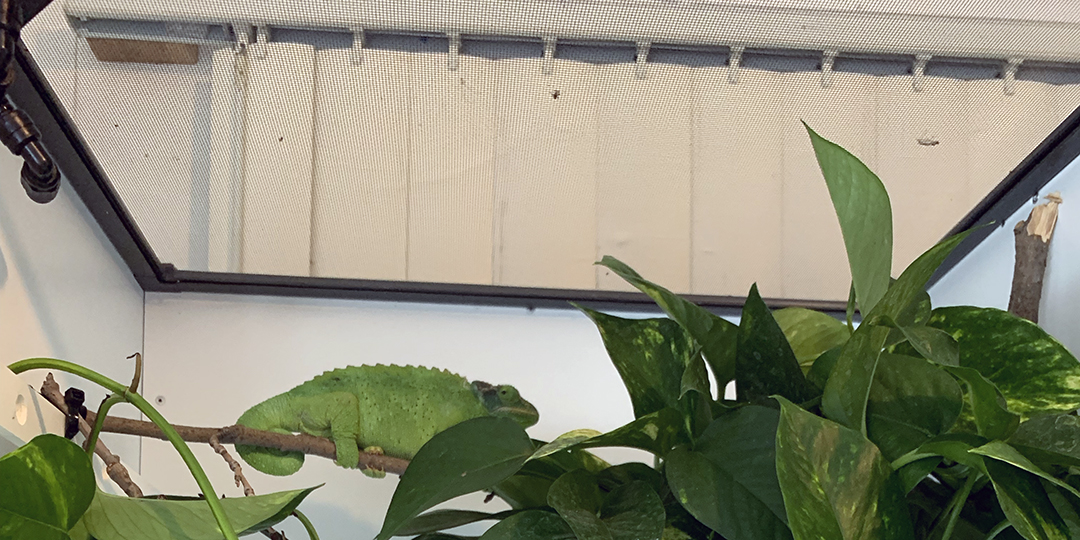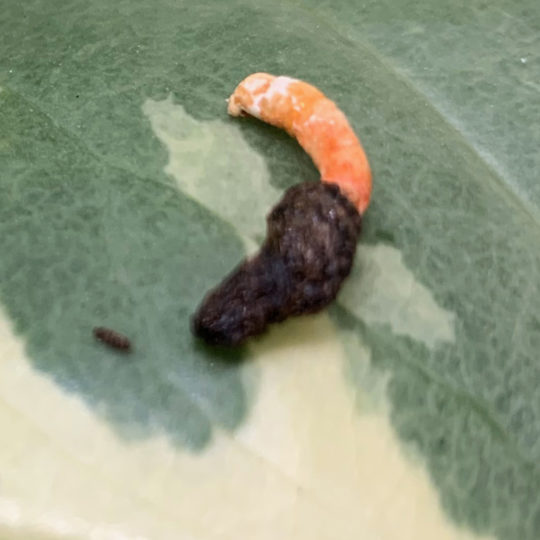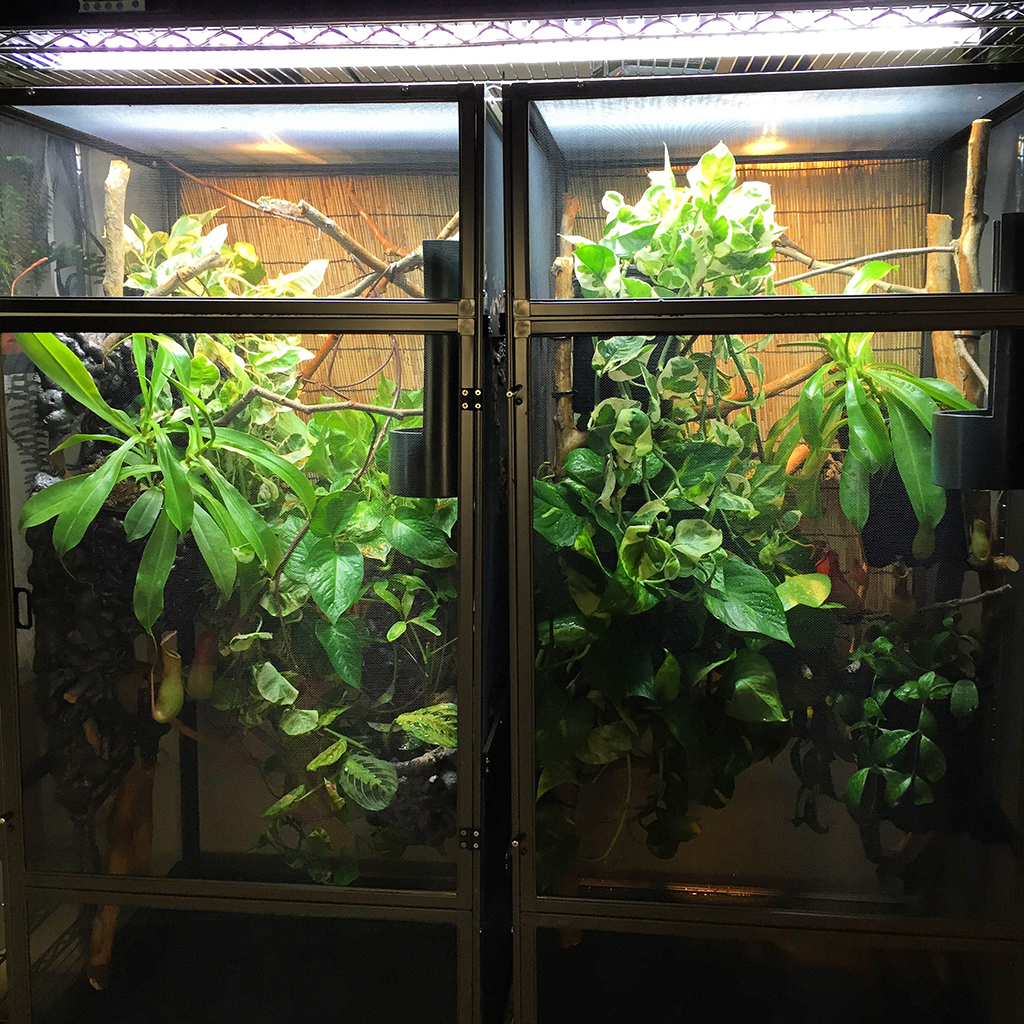Summary: Understanding Chameleon Feedback
- Listen closely to what your chameleon is saying to optimize your cage
- Chameleons will communicate their thoughts
- Listen and change = happy chameleon
Introducing Your Chameleon To Its New Cage
It is normal for your chameleon to be restless for the first couple of days in a new cage. Your chameleon is spending this time exploring the limits of their new home. During this time you will see behavior that would normally signal trouble such as climbing the sides of the cage and hanging upside down from the top. The normal pattern is one or two days of restless pacing and exploring and then settling in. If your chameleon continues to pace and be restless after two days then there may be something bothering him. It will be then that it is time to re-evaluate each condition and study his behavior.

This female Jackson’s Chameleon is restlessly walking the top screen when she was placed in this new cage. She has an outdoor cage and just needs to come in for a little while due to the cold. Although Jackson’s are able to overwinter outdoors in coastal California, I brought all my pregnant females indoors. The cages are sparse, but fulfill the basics of the Forest Edge 4+4. I am housing them in Dragon Strand Medium Wide Breeder series cages which are 22″ wide x 17″ deep x 30″ high. Although smaller than recommended they work because they have three solid sides and so actually provide more security than a larger screen cage. Two of the four settled in without and issue. The other two are nervously pacing the cage. The difference? The nervous ones are on the bottom shelf of the rack while the content ones are at the top of the rack. Height makes all the difference in the world! So, my next steps are to see if the bottom row chameleons settle in over the next 24-36 hours. If not then I need to set up a second rack where they can be on the top held.

This is one of the two female Jackson’s Chameleons on the top row. She displayed no nervousness or screen walking. The cage set-up was identical. The only difference was that her cage was on the top half of the rack. Position of the cage is important!
Screen Walking, Restlessness, or "Pawing" To Get Out
While the chameleon will pace the cage for the first couple days they should settle in quickly after that – especially if they are captive hatched. If there is a continued pacing of the sides of the cage then there is something that must be addressed and corrected. Unfortunately, this is not an easy task. You have the challenge of getting into a chameleon’s head and figuring out what is bothering them. Do they have a dense leafy area that they can rest in? Is there a cat, dog, or bird that is in visual range? Are they warm enough? Too warm? They are trying to get out and it falls on your shoulders to find out why.
Beware of falling into the trap of thinking it is because they want to be out to play with you. There are a small number of chameleons that may have no fear of humans. But to believe that the behavior of screen walking is because they want to come out and play will hide the much more likely issue that there is something they are not content with in the cage. If you are convinced your chameleon wants to be with you then consider that they would act like a chameleon when you are not there. If you walk in and they are crawling the side then they are not happy with the cage.
Reflections
With the advent of more and more glass and acrylic side cages coming into use in the mainstream, people are wondering about the complication of reflections inside the cage. This is a strange situation where some keepers are convinced their chameleon reacted to a reflection and then some multi-generational breeders using glass cages report never seeing a reaction.
If a reflection is bothering your chameleon he will either react defensively or aggressively towards the area with the reflection. If you are unsure what this would look like, get a mirror and hold the mirror about 9″ in front of your chameleon. your chameleon. What is the reaction? And, now, is that the behavior you are noticing in the cage?
If you do determine that a reflection is causing an issue then you can look at the placement of the lighting system. Changing the location of the lights will change the reflection map. You can also add plants, branches, or any other cage elements to beak up the visuals of the offending area.
The benefits of having solid sides are significant and if you need these then it is worth dealing with any reflections that may arise.
Too Hot or Too Cold

A chameleon doing normal temperature regulation will come up to the basking bulb dark, flatten its body, bask, then lighten up and crawl away. If the bulb is not hot enough then your chameleon will either spend hours, dark under the light or even crawl upside down on the screen top and park himself under the basking light. This, of course, is dangerous for burns. But it is these behaviors that you are looking for to tell you that there is a problem with too cool of temperatures.
If temperatures are too high you will notice your chameleon showing faded out colors and spending time in the lower part of the cage.
There is one more condition to watch out for and that is a basking temperature that is too high. This can result in burns. A common scenario for this to happen is when the ambient temperatures are cool and the only heat is a spot lamp which is too powerful. The chameleon is forced to choose between being too cold and getting burned by heat. Chameleons have repeatedly shown that they would rather burn themselves than be cold.
The way to resolve this is to get a higher wattage bulb and mount it higher up so that the proper heat covers the entire body area of the chameleon.
Is Your Chameleon Hydrated?
Dialing in the hydration cycle is one of your most important jobs. You set up your hydration cycle and then look for feedback as to how well the chameleon is hydration.
A well hydrated chameleon will act indifferently to water, the poop will be a moist “biscuit”, and the urates will have 50% or less orange color.
If you chameleon rushes to water, produces dehydrated poop or orange urates then there is a problem and the solution is to increase the water availability. But do not confuse the reflexive drinking of a chameleon in a shower or direct misting as gulping water. Drinking is a normal reaction to having water by their mouths whether the are thirsty or not.
I am concerned about this chameleon and overhauled his hydration system. The poop appears dry and the urates are almost all orange. This is not cause for panic, but a quick change of his hydration is in order. I reviewed both hs fogging and misting schedule and include a dripping session in the afternoon as a backup. That he did not drink desperately with the dripper let me know that this was not a serious dehydration. His poops after the hydration change were more satisfactory.
My Chameleon is Not Eating! What Does This Mean?
A common situation that raises concern with chameleon keepers is when their chameleon stops eating. Ironically, wit no other symptoms suggesting internal distress, refusing to eat is usually a sign of overeating.
Chameleons are both ectothermic (cold-blooded) and quite sedentary. They do not need many calories to live and do their chameleon thing. We humans, on the other hand are used to having to constantly consume calories to keep our endothermic (warm blooded) and active body functioning. So we are predisposed to give whatever we love food until they stop eating. And then we reset and repeat everyday.
Chameleons have an instinct to eat whenever they can so they will initially respond to this treatment, but sooner or later it will just be too much eating for them. When this happens they will ignore food unless it is a special treat or especially attractive. Green or flying or wormlike are often candidates for chameleons eating it even if they aren’t hungry. And this is how our chameleons become refusing to eat anything other than a specific favorite feeder. They are no hungry. They are eating for pleasure. Of course, this is an unhealthy situation. Adult chameleons only need a couple of feeders every other day. If you are feeding more than this you will be creating a situation where they do not feel the need to eat for hunger reasons.
The response is simple. Don’t feed him for two or three days. Then offer a standard feeder (not a treat) by hand. If he does not eat then come back and repeat in a couple days. When the hunger comes back he will have no problem eating.
Why is My Chameleon Eating Dirt?
When your chameleon takes bites out of the dirt he is communicating that he has a lack of some mineral in his diet. The correction is to review your supplementation. There is something missing. As each situation is different this may not be as easy as just starting to add a mineral powder. If you already are using a mineral powder then it becomes tricky to figure it out. Are the feeder insects losing the powder coating before being eaten? You will have to look at each step in the feeding process to figure out where the failure point is.
Why is My Chameleon sleeping during the day? Falling from the branch? Or doing this OTHER thing? ...
Chameleon are complex, individual creatures and have communication all their own. If you see a behavior or condition that you are not sure about, check out the follow two courses on behavior and medical conditions to see if what you are seeing matches something there.
Navigation
This seminar is part of the introductory course Maintaining Your Chameleon Cage which, in turn, is a module within the even larger Term 1: Getting Started With Chameleons. Here we took cues from our chameleon to help us learn how to tweak our husbandry for better results. In the next module we will turn our attention to keeping our plants alive.








